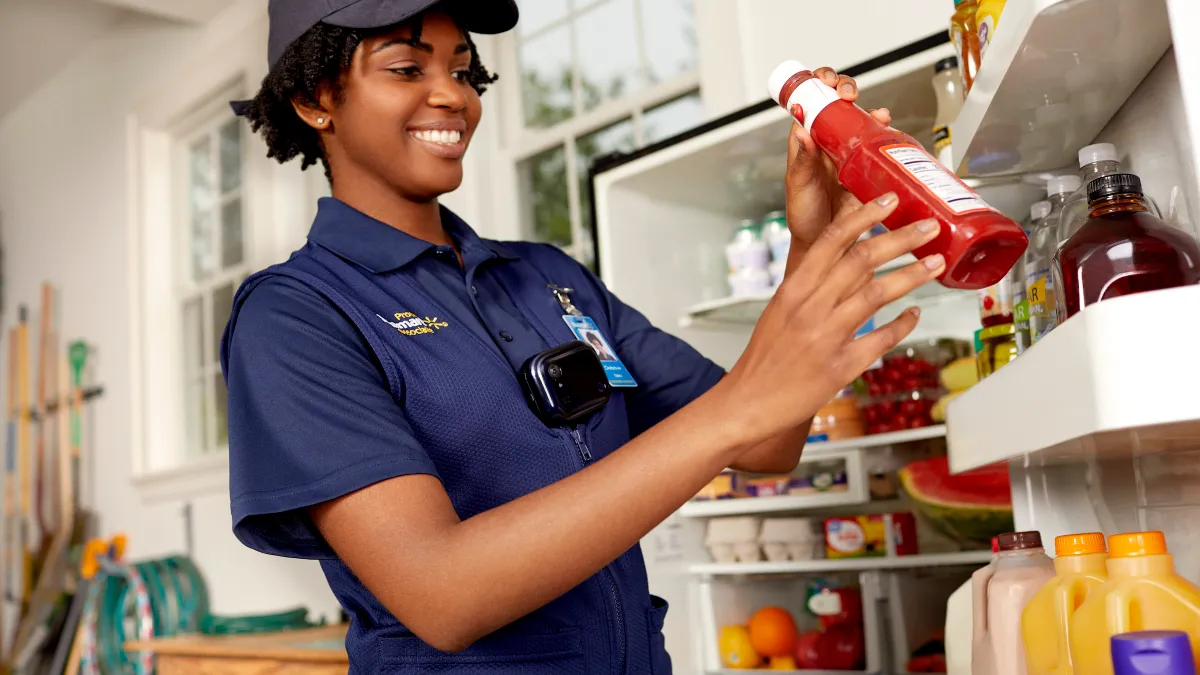UPDATE: October 15, 2019: On Tuesday, Walmart is rolling out its InHome Delivery to the three cities previously announced. To take advantage of the service, customers can join a membership program for an introductory price of $19.95 a month. They also have to buy a smart door lock kit or smart garage lock kit for $49.95, which comes with free installation and a free month of unlimited grocery delivery. The smart lock's Bluetooth technology generates a one-time access code that is sent to the Walmart employee but is only valid during the specific scheduled delivery time. The 30,000 to 35,000 items available on Walmart's grocery app are available for InHome delivery.
Dive Brief:
- Walmart announced in a blog post it will launch a service this fall that delivers groceries directly to shoppers’ refrigerators and countertops. Walmart InHome Delivery will be available to nearly 1 million people in three cities: Kansas City, Missouri; Pittsburgh; and Vero Beach, Florida. Walmart did not specify an exact start date for the service or the cost for shoppers.
- To use the service, customers place an online order, then select InHome Delivery at checkout. An InHome employee collects the order and uses smart lock technology to access the home and deliver the groceries. Each employee has a wearable camera that allows shoppers to follow their progress inside the home. The company also said that later this year, InHome Delivery employees can collect returns on behalf of customers.
- Each InHome employee will undergo "extensive" training on how to properly enter shoppers' homes and store their goods, Marc Lore, president and CEO of Walmart e-commerce, said in a blog post, and will additionally be required to have been with the company for at least a year, according to The Wall Street Journal. Walmart has been stealth testing the service in New Jersey over the past six months.
Dive Insight:
This isn’t Walmart’s first foray into in-home delivery. In 2017, the retailer partnered with smart lock maker August Home on a small test in Silicon Valley in which workers brought packages inside consumers’ houses and placed groceries in their fridges.
Walmart quickly shuttered that program, but clearly saw an opportunity to address the model once again, particularly as rival Amazon makes similar moves. Key by Amazon is available in 50 cities and delivers inside consumers’ homes, garages and car trunks, but does not include groceries.
Indeed, grocery — and in particular fresh grocery — is a major advantage for Walmart in the tit-for-tat battle with its retail nemesis. While Amazon resuscitates AmazonFresh and gradually scales same-day service through Whole Foods stores, Walmart is on track to have grocery pickup in 3,000 markets by the end of this year and delivery in more than 1,000. Food and beverage is Walmart’s way into customers’ homes.
Now, Walmart literally wants access to those homes. Question is, will consumers let them in?
The retailer is betting on the convenience of the service to overcome any reservations shoppers might have about a worker entering their home and stocking their fridge. But trust issues have hampered online grocery’s growth to this point, with many consumers unwilling to let someone else pick their fresh fruits and vegetables and to select just the right cut of meat for them, despite the time savings this offers.
Walmart is addressing this barrier through transparency and employee training. Shoppers can watch their InHome Delivery employee at work inside their home — a feature that seems more like a reassurance than a practical tool that will be widely used. Walmart will also include a bio of each employee so that they're less of a stranger to shoppers.
As for the training program, Lore had this to say in his blog post:
“These associates, whose jobs are focused on this service, will also go through an extensive training program which prepares them to enter customers’ homes with the same care and respect with which they would treat a friend's or family’s home — not to mention how to select the freshest grocery items and organize the most efficient refrigerator.”
In addition to convenience, Walmart is also betting on the growing adoption of smart-lock technology to boost adoption of its InHome service. According to CNET, one in four broadband-connected consumers say they intend to buy a smart lock sometime in the next year. As the technology evolves and becomes more affordable — top models can be had for between $150 and $250 each, according to CNET — adoption will likely accelerate.
In a news conference in June, Lore said he expects to see early adopters gravitate towards InHome Delivery, then promote the service through word of mouth.













